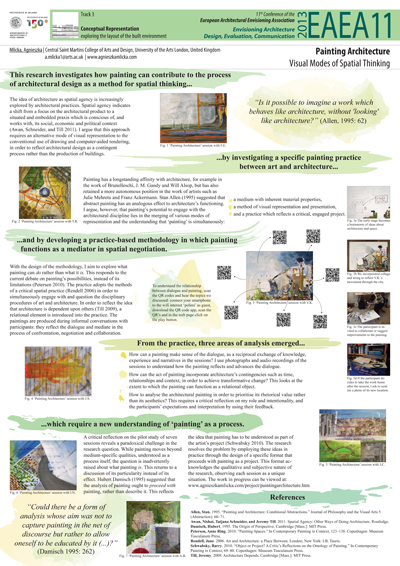11th EAEA Envisioning Architecture: Design, Evaluation, Communication Conference in 2013
Track 3 | Conceptual Representation | Exploring the layout of the built environment
Painting architecture: visual modes of spatial thinking
Keywords: painting practice; architectural representation; spatial agency
ABSTRACT
Is it possible to imagine a work which behaves like architecture, without 'looking' like architecture? With this question, Stan Allen suggested a new line of affiliation for architecture: painting, based on an analogous effect to architecture’s functioning rather than its materiality. This practice-based PhD builds upon Allen’s suggestion by analysing how contemporary painting can contribute to ‘design thinking’ by its potential to simultaneously visualise the material and the immaterial qualities of architecture. It argues that in order to reflect the paradigmatic shift in the architectural profession, from an autonomous art of design to a spatial agency, a different mode of architectural representation is required. Architecture’s long-standing affinity with drawing as its primary tool is based on the convention that a representation relates to the building, either as anticipated design or as documentation of the finished product. As such, drawing developed into a tool of descriptive geometry, which is perpetuated in digital and virtual rendering techniques. In contradistinction, painting practice is proposed as a method that can bridge the gap between visualising the architectural product and thinking about architecture as a practice inherently contingent on people, networks and processes.
The project ‘Painting Architecture’ explores how painting can trace this process of ‘spatial thinking’ during dialogue sessions with participants, thereby merging the initial stage of architectural projection with the briefing process and the final product design when the painting is given to the participant. Painting offers medium-specific qualities such as the brush stroke, multiple styles of representation and references, colour and layering which enable to reflect on architecture as part of a larger process of spatial production. However, by testing what painting can do rather than what it is, this project essentially questions the rationale for using painting. It argues that painting is the sum of its three equally essential parts; it is simultaneously a medium with inherent material properties, a method of representation and presentation, and a practice which reflects the underlying project. Consequently, the architectural paintings are analysed within the framework of visual rhetoric, which emphasises the intentionality, expectations and interpretation of the work. The understanding of painting as a mediator, and potentially as a visual argument or treatise, fundamentally redefines the concept of painting in the expanded field of architecture; rather than asking how painting functions within architectural space, it asks how painting can contribute to the architectural discipline. While this challenges the ‘status’ of painting as fine art, it provides scope for considering painting as a critical, engaged tool for addressing the wider social, political and economic issues that architecture depends on.
AUTHOR
Agnieszka Mlicka
Central Saint Martins College of Arts and Design, University of the Arts London, United Kingdom
